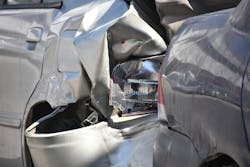Most people are unsafe drivers, as is evidenced by the fact that most people leave insufficient room between their car and the one in front of them. Defensive driving courses teach students to maintain a “space bubble” around the car. These courses also train students to look through and past the car in front of them to anticipate sudden changes in traffic flow.
Beyond the “regular unsafe drivers” are the super unsafe drivers. These include:
- People who text while driving (or who are deeply engaged in a phone conversation).
- “Race car drivers” (in their own minds).
- Dawdlers (especially those who crawl the Interstate on ramps, only to “merge” at 30 mph below the prevailing traffic speed).
- People who are eating and drinking with neither hand on the wheel.
- People with “I have to pass” OCD.
- Frequent lane changers, also called “weavers.”
The apparent aversion to safety even extends to parking lots. You're about to back into a space (so that you don't back out into pedestrian traffic) when some idiot, oblivious to your vehicle or the fact you are trying to execute a safe parking maneuver, pulls into that space. Good thing you saw him and stopped in time. (Note that UPS fires drivers for pulling head first into a parking spot; UPS does not want them backing into pedestrians, it wants them backing into parking spots instead).
Should you give him a piece of your mind? Let's say you're in your company vehicle, with test equipment, tools, and materials in the back — and the company logo on the side. There is only one correct answer: Be polite.
What if you're not in your company vehicle? The same thing applies, even though there's no company logo. Getting into a needless, stressful, potentially dangerous shouting match with a stranger might satisfy a primal urge, but it won't accomplish anything useful.
There's no sense in spreading negativity. If the other person is driving badly because they are already stressed out, you don't want to add more stress. You never know what kind of crazy thing that person will do in response. You just have to let it go.
Keep your own sense of calm. Your main goal is to safely arrive at your destination. Another goal is to arrive there without being rattled because of someone else's bad behavior and poor judgment; don't give a stranger that kind of control over you.
What if you are the passenger, and the person who is driving the car you are in is exhibiting these bad behaviors? Handle the unsafe act the same way you would handle an unsafe act on the job. Keeping your voice calm, say something like, “I appreciate that you took on the task of driving. But can you tell me what is unsafe about how you are driving at the moment?”
By starting a conversation instead of criticizing the other person, you are likely to get a positive change in behavior rather than a negative response. You can't start a conversation with the drivers of other cars as you're going down the road, which is why you must let those go. But when you are a passenger, you can.
Just keep in mind how you like people to talk to you. Nobody likes being jumped on and told they are wrong. Asking someone to tell you what is unsafe about what they are doing nearly always leads to a better outcome. This is the method DuPont implemented decades ago, and it has proven to be effective. DuPont calls its method the STOP method, because the first thing you do is ask the other person to stop what they are doing. Obviously, that doesn't work when you are a passenger in a moving car.
About the Author

Mark Lamendola
Mark is an expert in maintenance management, having racked up an impressive track record during his time working in the field. He also has extensive knowledge of, and practical expertise with, the National Electrical Code (NEC). Through his consulting business, he provides articles and training materials on electrical topics, specializing in making difficult subjects easy to understand and focusing on the practical aspects of electrical work.
Prior to starting his own business, Mark served as the Technical Editor on EC&M for six years, worked three years in nuclear maintenance, six years as a contract project engineer/project manager, three years as a systems engineer, and three years in plant maintenance management.
Mark earned an AAS degree from Rock Valley College, a BSEET from Columbia Pacific University, and an MBA from Lake Erie College. He’s also completed several related certifications over the years and even was formerly licensed as a Master Electrician. He is a Senior Member of the IEEE and past Chairman of the Kansas City Chapters of both the IEEE and the IEEE Computer Society. Mark also served as the program director for, a board member of, and webmaster of, the Midwest Chapter of the 7x24 Exchange. He has also held memberships with the following organizations: NETA, NFPA, International Association of Webmasters, and Institute of Certified Professional Managers.
